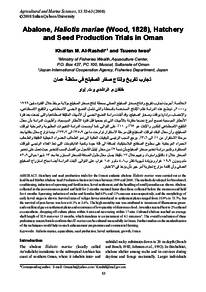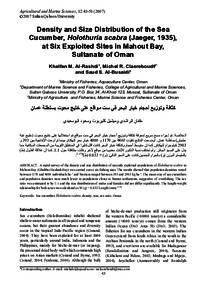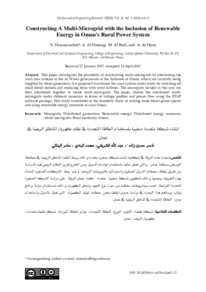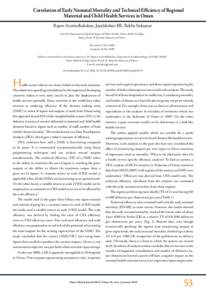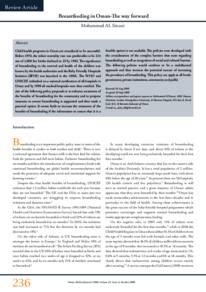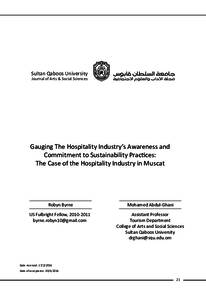Document
Abalone, Haliotis mariae (Wood, 1828), Hatchery and Seed Production Trials in Oman.
Contributors
Iwao, Tsueno., Author
Publisher
جامعة السلطان قابوس. كلية العلوم الزراعية والبحرية
Gregorian
2008
Language
English
English abstract
Hatchery and seed production trials for the Omani endemic abalone Haliotis mariae were carried out at the land-based Mirbat Abalone Seed Production Station in Oman between 1999 and 2000. The methods developed for broodstock conditioning, induction of spawning and fertilization, larval settlement, and the handling of small juveniles are shown. Abalone collected in the post-monsoon period and held for 2 months matured faster than those collected before the monsoon and held for 6 months. Spawning induction of males and females had 63% and 11% success rates respectively, and the morphology of early larval stages is shown. Survival rates of veliger larvae introduced to settlement plates ranged from 35.9% to 73.7%, but the survival of post-larvae was low at 0.1% to 3.6%. The high mortality rate was attributed to invasions of filamentous green- and coralline algae on settlement plates and occurrence of low quantity of diatoms as food. Juveniles reacted best to 2% ethanol as anaesthetic, dropping off culture plates within 4 min and recovering within 17 min. Cultured abalone reached an average shell length of 52.9 mm over 13 months, which translates to an increment of 4.1 mm.mon'. The overall conclusion of these preliminary research trials confirms that H. mariae can be cultured successfully in Oman. Further studies on the standardization of the techniques would help in stock enhancement programmes and commercial farming.
Member of
ISSN
2410-1079
Resource URL
Citation
Al-Rashdi, K., & Iwao, T. (2008). Abalone, Haliotis mariae (Wood, 1828), Hatchery and Seed Production Trials in Oman. Agricultural and Marian Sciences Journal, 13 (1), 53-63.
Arabic abstract
أجريت تجارب تفريخ وإنتاج صغار الصفيلح العماني بمحطة إنتاج صغار الصفيلح بولاية مرباط خلال الفترة ما بين 1999 و 2000 م. توضح هذه الدراسة نظم الإنتاج المستخدمة بالمحطة والتي تشمل النضج الجنسي الاصطناعي، والتلقيح الاصطناعي، والإخصاب، وإدارة يرقات وصغار الصفيلح، وقد أثبتت دراسة النضج الجنسي أن الأمهات المكيّفة اصطناعيا والتي جمعت بعد فترة الأمطار الموسمية تصبح أسرع نضجا مقارنة بالأمهات التي تم جمعها قبل فترة الأمطار الموسمية ، وأظهرت الدراسة بأن معدّل التلقيح الاصطناعي للذكور والإناث هو 63% و 11% على التوالي. كما أوضحت الدراسة التغييرات المظهرية والمرحلية ليرقات الصفيلح، وأن معدل البقاء ليرقات الصفيلح قبل مرحلة الاستقرار تراوحت ما بين 35.9% إلى 73.7%، بينما تراوح معدل بقائها بعد مرحلة الاستقرار من 1 % إلى 3.6%. يرجع السبب الرئيسي للوفيات العالية إلى نمو الطحالب الخضراء الخيطية الدقيقة والطحالب الحمراء المرجانية على سطوح الصفائح البلاستيكية ، إضافة إلى قلة جودة وكمية الداياتومات التي تعدّ الغذاء الرئيسي لليرقات المستقرة وتشير دراسة تخدير صغار الصفيلح بأن نسبة 2% من مخدر إيثيل الكحول من أفضل النسب للتخدير حيث تعمل على تخدير الصغار خلال 4 دقائق واسترداد وعيهم خلال 17 دقيقة. يصل معدل طول الصدفة للصغار المستزرعة بعد 13 شهرا حوالي 52.9 ملم وبوزن 19.9 غرام وبزيادة شهرية تقدر ب 4.1 ملم و 1.5 غرام، على التوالي. أثبتت الدراسة أيضا نجاح استزراع الصفيلح العماني وأن إقامة مزارع تجارية أمر جدير بأن يؤخذ في الاعتبار.
Category
Journal articles

